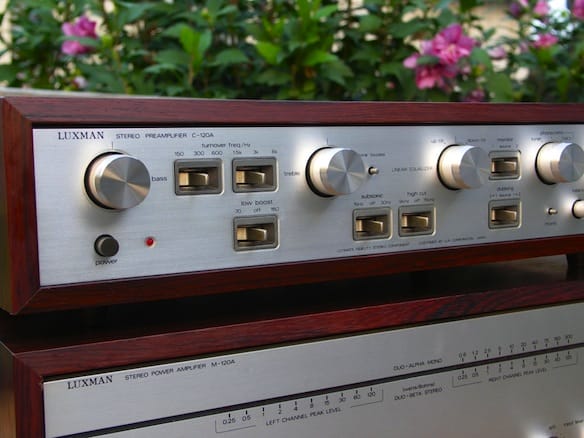
Image credit: Audio Karma.
Stereo Preamps
A stereo preamp takes a low voltage line signal and transforms it to an amplifiable signal of moderate voltage for sound production and reproduction. The objective is to minimize the signal-to-noise ratio while bringing the voltage and amplification up to optimum hearing levels.
The use of the term preamp has become ubiquitous in the audio and video industries, so we will try to differentiate between colloquial and professional uses of the word, “preamp.”
Many stock stereo amplifiers, and worse, many-channel audio-visual amplification systems identify an integral preamp, which is, in reality, little more than a switch between different amplification channels.
Types of preamps
Preamps take three forms: current sensitive, parasitic capacitance and charge-sensitive.
The latter, charge-sensitive, or charge amplifier is something of a misnomer, as it does not change the charge but rather converts the input charge to a voltage across two capacitors, effectively acting as a charge to voltage converter. Piezo transducer guitar pickups and photodiodes are examples of a charge- sensitive preamp.
The current-sensitive preamp is a current to voltage amplifier which works with the super-diminutive current signals found in photometry and semiconductor research, utilizing low impedance input and low-noise output.
Parasitic capacitance technology uses a feedback capacitance loop and switch to eliminate noise from parasitic capacitance at the input stage.
Mies van Der Rohe’s statement that “less is more” governs preamplification theory, with silence (in terms of noise) being the objective. Priceonomics will help you determine which preamp best suits your audiophile needs.
Applications
Preamps are ubiquitous in audio and video gear. Many amplifiers contain an integral preamp, and are known as integrated amplifiers. Many microphones have an integral preamp that converts line level input to an amplifiable voltage. Musicians commonly use a preamp in their signal path to contour their sound before the amplification stage. Hybrid preamps that use vacuum tube technology in the input phase are standard in the industry. Many Digital-to-analog converters have an integral preamp, and can be used as both a DAC and a preamp.
Passive Versus Active
An active preamp uses circuits to amplify line-level voltage, also known as unity gain, above the input level. A passive preamp actually has no device to increase gain, and transforms the voltage to match impedance with the next line stage. Passive preamps therefore put all of the voltage requirements on the input line source. Then there are switchable preamps that can convert from active to passive capability. Creek and Channel Islands Audio produce popular models with this feature.
Passive preamps are preferred when working with computer audio configurations where all the components are in proximity to each other. Short cable runs between components suit passive preamps, while longer cable runs require active preamplification due to voltage loss and impedance issues in cable voltage resistance, or line drag.
Integral Preamps
As many stereo components contain integral preamps, such as amplifiers and digital-to-audio converters, adding a preamp to your signal path may be redundant or unnecessary. By connecting a DAC with an integral preamp directly to the amplifier, the signal path is simplified over the inclusion of an outboard preamp, cables are eliminated and sound quality is optimized. This is particularly desirable when working with all digital sources. A DAC with an integral preamp and variable outputs not only eliminates another stage in the signal path, but saves the user the additional cost of a preamp.
In deciding which option is the best for your listening preferences, it is good to consider the ideal: Minimizing the signal-to-noise ratio. A preamp will amplify the voltage, while the primary amplifier will increase the current to drive the loudspeakers. The more remote the preamp from the final amplification stage, the more desirable. For those considering an outboard DAC, particularly for computer audio systems, choosing one with a preamp is a good option.



